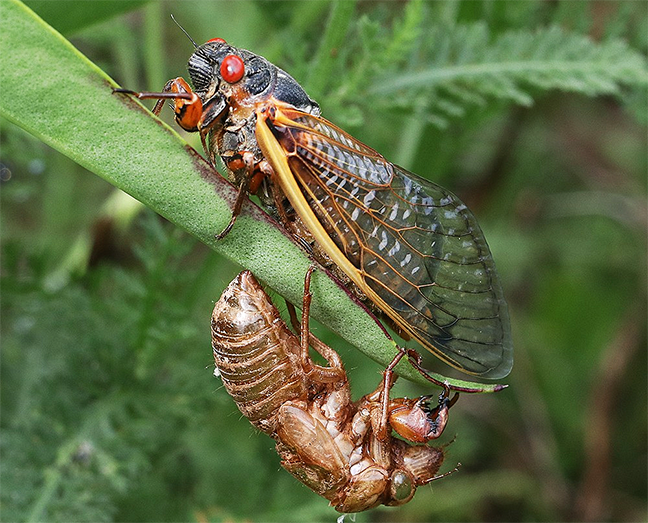Welcome!

Photo by Debbie Roos, NC Cooperative Extension
Another concert series has begun
They’re baaack!
The cicadas, those singing insects that serenade us constantly for weeks on end, are returning to the East Coast after 13 years of hibernation.
Wait. Didn’t we just have an invasion of cicadas a year or two ago? Was that a different gig?
Nah, say scientists, just another species of cicadas — what we used to call locusts.
Apparently, there are several species of periodical cicadas and about 30 broods, and they reappear normally at 13- or 17-year cycles. They’ve learned to stay underground all that time to evade predators.
Debbie Roos, Cooperative Extension agent in Chatham County, wrote this: “The last time we saw these 13-year cicadas in North Carolina was in 2011 when we spent over a month in the company of millions of cicadas, marveling at the surprisingly loud and surreal din of their mating calls as we shared cicada stories with friends and neighbors. The ubiquitous insects were a big hit with kids, dogs, cats, chickens and copperheads (the snakes love to snack on them).”
Insectivores devour the little fellas but since cicadas don’t come out every year, mayflies, ants and termites are flummoxed when they can’t find any of the juicy nymphs. Eventually, ants forget about cicadas and concentrate on entering your house to find sweet treats instead.
Entomologists say the latest batch of cicadas start emerging once the ground temperature reaches 64 degrees. For cicadas, apparently, 64 degrees means it‘s time to get up, shed the exoskeleton and find a mate for one last fling.
Yep, they pair off, cruise the neighborhood while singing “their” song, make a little whoopie before laying about 500 eggs, then sing their swan song.
They’re able to sing by using muscles to buckle special ribbed membranes located on their abdomen. Cicadas can make more than one sound, from an alarm to a low amplitude song to the main ditty.
Interestingly, cicadas rarely sing while flying. Apparently, that’s like walking and chewing gum for some of us humans.
Cicadas aren’t necessarily considered pests, except perhaps for all that singing. In fact, in China and Japan, cicada remains have been used to cure ear aches. Sort of like the cause being the cure, I guess.
The johnny-come-latelies have been used for food, natch — remember locusts in the Bible? Hard to believe, but they’ve been eaten just about everywhere they show up.
But then chocolate-covered ants and fried grasshoppers are considered delicacies by some.
What’s most intriguing to me is that cicadas are about as indestructible as, well, roaches. Despite removal of their natural habitats — trees — in much of Europe and North America, there’s no indication that their numbers have dropped.
On the contrary, they’ve learned to make do with orchards, urban street plantings and even the edge of roads.
While cicadas aren’t necessarily considered pests, Roos said, “Many folks who experienced large cicada populations in 2011 were left with damaged young trees and bushes where the female cicadas cut slits into tree branches to lay their eggs.”
Whatever the case, cicadas seem to be like the weather — everybody talks about it but nobody does anything about it.
So we might as well just coexist with this 13-year crop, enjoy the singing (as much as possible), watch them flying around the yard and sweep up their remains from the doorstep.
And remember, we won’t see their offspring for another 13 years.
But then again, there’s another brood underneath our feet waiting for their curtain call. They’re probably tuning up their ribbed membranes in anticipation of the maestro striking up the band.
In the meantime, spring is in the air — not to mention tree pollen, ragweed and hay fever.
Enjoy.
As for me, I love just about any kind of music, just not for weeks on end.
